#great depression in canada
Text

Unemployment relief delivered by the government in minuscule amounts, The Worker. July 3, 1933.
#toronto#canadian labor defence league#unemployment relief#poverty relief#capitalism in crisis#unemployment#starve or freeze#bennett government#communists#great depression in canada#political cartoons#editorial cartoons
191 notes
·
View notes
Text

Felix H. Man, Winnipeg, Manitoba, September 7, 1933 (PA-145949).
#winnipeg#felix h. man#great depression in canada#vintage advertisement#down and out#unemployment#single unemployed men#transients#canadian history#manitoba history
23 notes
·
View notes
Text

"LAZIEST UNDERGRADS HIRE STENOGRAPHER," Toronto Star. December 14, 1931. Page 1.
---
Lectures Taken in Full for 50 Cents Week
---
Commerce students at University of Toronto have decided it is too much of an effort to take notes in lectures so they have arranged to employ a stenographer. The scheme is to be tried out immediately in the political science course. For six economic periods a week the students will be able to concentrate on the lecturer, or to dream dreams.
The committee in charge has arranged notes will cost a maximum of 50 cents a week for each student. A stenographer will attend the lectures and take down a word for word copy. This will be typed and mimeographed and the copies distributed to students in the scheme.
#toronto#university of toronto#business school#business students#university students#stenography#rich people problems#commerce department#great depression in canada#mimeograph
46 notes
·
View notes
Text
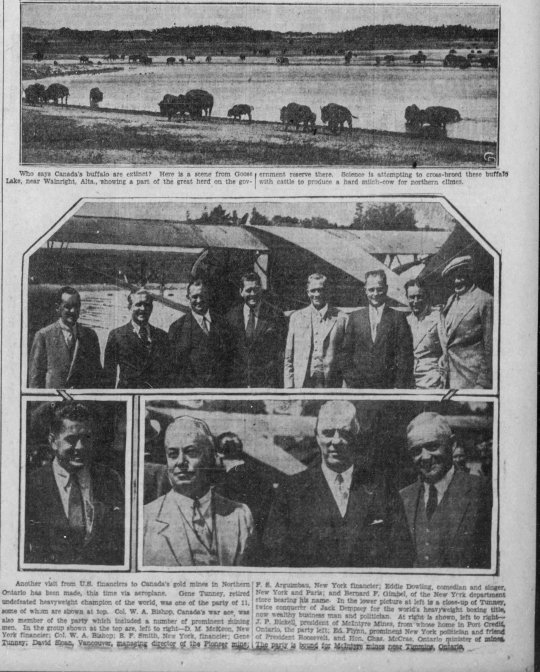
"Who says Canada's buffalo are extinct? Here is a scene from Goose Lake, near Wainright, Alta, showing a part of the great herd on the government reserve there. Science is attempting to cross-breed these buffalo with cattle to produce a hard milch-cow for northern climes.
////
Another visit from US financiers to Canada's gold mines in Northern Ontario has been made, this time vis aeroplane. Gene Tunney, retired undefeated heavyweight champion of the world, was one of the party of 11, some of whom are shown at top. Col. W. A. Bishop, Canada's war ace, was also member of the party which included a number of prominent shining men. In the group shown at the top are, left to right - D. M. McKeon, New York financier; Col. W. A. Bishop; B. F. Smith, New York, financier; Gene Tunney, David Sloan, Vancouver, managing director of the Plonser mine, P. S. Arguimbau, New York financier; Eddle Dowling, comedian and singer, New York and Paris: and Heard P. Gimpel, of the New York department store bearing his name. In the lower picture at left is a close-up of Tunney, twice conqueror of Jack Dempsy for the world's heavyweight boxing title, now wealthy business man and politician. At right is shown, left to right - J. P. Bickell, president of McIntyre Mines, from whose home in Port Credit, Ontario, the party left; Ed Flynn, prominent New York politician and friend of President Roosevelt, and Hon. Chas. McCrae, Ontario minister of mines. The party bound for McIntyre mines near Timmins, Ontario."
- from the Kingston Whig-Standard. June 26, 1933. Page 10.
#northern ontario#timmins#mining company#financial capitalism#stock promoter#financiers#famous athlete#billy bishop#capitalism in canada#gold rush#resource capitalism#great depression in canada#northwestern ontario#resource extraction#vancouver#port credit#bison#the passing of the buffalo#alberta history
24 notes
·
View notes
Text
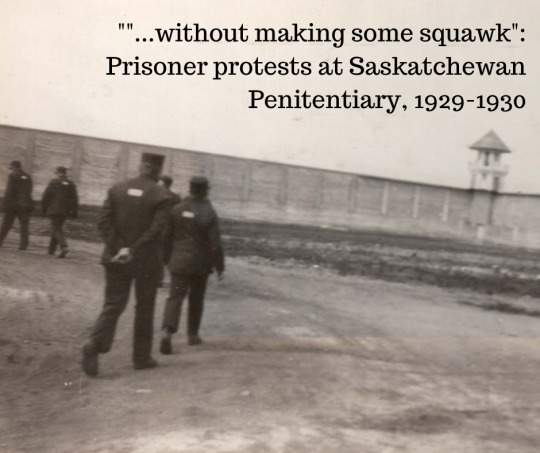
On November 14, 1929, a serious prison strike nearly broke out at the Saskatchewan Penitentiary in Prince Albert. Only by the narrowest of chances was the plot discovered by staff and the strike averted. The strike leaders were two convicts, Ashton and Jones, who referred to themselves in furtive notes as “sweethearts” and “lovers” - they dreamed of escaping to be together. Two hatchet-men from Ottawa were sent to clean up, senior officers of the penitentiary were dismissed, and the whole affair hushed up, save for a few stories in the newspapers. This is part of my rambling, fully informal, draft attempts to understand the origins and course and impact of the 1930s ‘convict revolt’ in Canada, and other issues related to criminality and incarceration Canadian history. (More here.)
Saskatchewan Penitentiary was, at the time, the newest federal penitentiary in Canada. Opened in 1911, to replace the territorial jail at Regina, parts of it were still under construction in 1929. UBC penologist C. W. Topping praised Sask. Pen as “the finest in the Dominion,” with supposedly ‘modern’ features in the cell-block and workshops, including an up-to-date brick factory that produced for federal buildings in the Prairies. Discipline and the organization of staff and inmates was functionally the same as everywhere else in Canada, however: forced labour, the silence system, limited privileges and entertainments, a semi-military staff force, and an isolated location far from major population centres.
The majority of inmates were sentenced from Saskatchewan and Alberta, but throughout the 1920s, 1930s and 1940s, Saskatchewan Penitentiary was used as an overflow facility from overcrowded Eastern prisons. In April 1929, dozens of mostly malcontent prisoners were transferred from Kingston Penitentiary. A “row” was expected with these men, but they were not closely watched or segregated from the main population. In November 1929, there were 430 prisoners at Saskatchewan Penitentiary – almost 60 were from Kingston.
The staff at Saskatchewan Penitentiary were warned on the morning of November 14, 1929, by a ‘stool pigeon’ that all work crews (called gangs) would refuse to leave their places of work “until all their demands were met with.” The stool pigeon had no idea who the ringleaders were or the demands, but the Deputy Warden, Robert Wyllie, ordered his officers to keep “a sharp lookout” for suspicious actions. Over 70 prisoners were working outside the walls in two large groups - building a road and laying sewage pipe - and they were supposed to be the epicentre of the strike. Indeed, the whole day of the 14th staff had observed them talking and passing hand gestures. Other warnings came in throughout the day, so Wyllie ordered the penitentiary locked down and the next day interviewed several inmates at random who confessed they had no idea how word about the strike leaked out. For reasons we’ll get into, they were "amazed at being locked in their cells" and surprised by the swift reaction from the Deputy Warden. During the morning of the 15th, one man named Ford was strapped 24 times for attempting to incite a disturbance in his cell block. Noise and shouting echoed throughout the ranges.

Prisoners working on a building foundation at Saskatchewan Penitentiary, c. 1927
In a state of growing panic, Wyllie first phoned Warden W. J. McLeod, on medical leave since September and so sick he could barely answer the phone. Wyllie then telegraphed Ottawa in a vague way, indicating a “serious situation” and asking for someone to come and take charge. Unsure of what was going on, the Superintendent of Penitentiaries, W. St. Pierre Hughes, dispatched five trusted officers from Manitoba Penitentiary, summoned the nearest RCMP detachment, and ordered his personal hatchet-man, Inspector of Penitentiaries E. R. Jackson, to proceed to Prince Albert and take charge. Jackson would be accompanied by R. M. Allan, Structural Engineer, who had worked at Saskatchewan Penitentiary for a decade in the 1910s and "who knew the prison from long experience."
Almost everything in the historical record about this episode comes from Jackson and Allan’s investigation. Their personalities and prerogatives colour completely the available accounts. They were not great record keepers. They were, like many civil servants of the era, bitchy gossips. Both men were known as severe disciplinarians. Jackson, though only appointed as an Inspector in 1924, had become an indispensable figure to Superintendent Hughes. Jackson would be sent to institutions that Hughes viewed as insufficiently following his regulations, or where inmate unrest posed a problem. Jackson was sent to handle a riot at St. Vincent de Paul Penitentiary in December 1925, ordering a brutal round of lashings against accused agitators. He headed the British Columbia Penitentiary for a year and a half when Hughes fired the warden on spurious ground.
It was at B.C. Pen that Jackson met Allan, then the Chief Industrial Officer, and the two would work together closely not just at Prince Albert but also in the construction and opening of Collin’s Bay Penitentiary in Kingston. Jackson also was acting warden at Kingston Penitentiary in summer 1930. One KP lifer testified in 1932 that Jackson was “a mean son of a bitch” who ordered draconian punishments for relatively minor offences. Allan would himself become warden of Kingston Penitentiary in mid-1934, and held that position until 1954.
In short, these were not men sympathetic to prison officers they viewed as incompetent or remotely curious about inmate complaints. Their investigation was about establishing blame and getting things back to ‘normal.’ They concurred with Hughes that "men never rebel where there is a tight grip retained of them by management." There is some truth to this, as sociologist Bert Useem has repeatedly argued in his work on American prison riots: a ruthless but effective and well organized prison staff is likely to stop even the best organized prisoner protest.
In a strictly hierarchical, patrimonial system like an early 20th century penitentiary, where all authority rests with a few men at the top, failures of leadership are often critical. This is a factor often overlooked in popular and academic histories of prisoner resistance and riots (rightly so, perhaps, as we should focus on the actions of the incarcerated, nor their jailers). Of course, strikes and riots in prisons, as elsewhere, never just happen – as Hughes himself noted, this “must have been developing for sometime - [revolts] never occur in a day or two."

This photo shows the chief officers involved in this event. From left to right: Saskatchewan Penitentiary Deputy Warden R. Wyllie and Warden W. J. Macleod, Superintendent of Penitentiaries W. S. Hughes, Accountant G. Dillon, Inspector of Penitentiaries E. R. Jackson.
Jackson quickly fixed blamed on Deputy Warden Wyllie. They were "very much surprised by the lack of initiative" of Wyllie, who seemed to have been cowed by the fifty men working on the outside that had tried to strike. This despite the presence of almost a dozen armed officers nearby! Wyllie had had a nervous breakdown from stress, and had allowed, in Jackson’s eyes, a “lack of efficiency and discipline” to pervade the prison. He was "indecisive" in giving punishments at Warden’s Court, causing “the inmates to gloat over and ridicule the officers…" Inmates charged with fighting, insolence, or swearing at officers were warned or reprimanded, the least severe punishment for such severe infractions of the rules. Several officers felt that “there was no use of reporting the inmates” and so they "closed their eyes to a lot of infractions." Another officer thought that since September 1929 "inmates had became cocky … would laugh in the my face and...tell me to report him when he liked...for it would do no good." This situation was very similar to Kingston Penitentiary before the riot in October 1932, and, indeed, typified the crisis of the 1970s in federal prisons as well.
The November 14-15 disturbance was actually not the first strike episode at Saskatchewan Penitentiary that year. There had been unrest or talk of strikes among the prisoners since early September, with a general atmosphere of defiance and mockery of authorities. Many inmates resisted by going “through the motion of working" but not actually completing tasks. There had been a work refusal in late September, and two other strikes or work refusals in the middle of October. In these cases Wyllie intervened personally, but did not investigate, punish the strikers, or rectify the situation. There are not even reports on file about these events, and the record of reports against inmates for violating rules bears out this feeling that prisoners would “have their own way” and no ‘effective’ action would be taken against their rebellions. That is, effective by the standards of guards, who expected their commands to be obeyed absolutely.
Few demands were discovered – or least Jackson did not think the ones he turned up were worth elaborating on. There seemed to have been general opposition to the Steward's department – the “grub” was satisfactory, but apparently not distributed fairly, according to the inmates. The Steward and Deputy Warden had allowed inmates to place “special instructions” for their meals, and they would shout out their orders like they were at a diner, or exchanged their tickets to swap meals. The queued, single file, food line, with no talking and the same meal for everyone, had disappeared, and restoring this system was Jackson’s first act when he took over. Of course, food in prisoner protests stands in for more than just a meal, while also representing a very basic need that is one of the few things to look forward to during days of monotonous labour.
Much of the unrest centred on certain work crews, whose officers were resented, and communication with family, better work arrangements, socializing, access to newspapers, all are mentioned in passing in the investigation files. The “Kingston boys” were also the loudest supporters or organizers of the strikes, and they apparently resented being exiled to Saskatchewan. At least one inmate, Radke, told other inmates he wanted the strike to force a Royal Commission to investigate the prison. This kind of demand would be repeated again and again in 1932 and 1933 during prison riots across Canada.

Cell block in 1930 at Saskatchewan Penitentiary. The beds in the corridors are due to severe overcrowding.
George Ashton was singled out as one of the organizers of the abortive strike. Serving a term for armed robbery, he was one of the Kingston transfers. On November 15, 1929, he was caught trying to throw a letter away. This letter is addressed to another inmate who he had hoped to escape with. Ashton, "a troublesome, Smart Alec kid,” was sentenced to be shackled for ten days to his cell bars and to spend sixty days in isolation. Typical of Jackson’s more ‘effective’ regime.
Ashton’s note was addressed to his 'Pal', Allen, alias Bertram Allen Jones. Both worked in different work crews labouring outside the walls. Ashton’s letter to Jones identifies him as his sweetheart and lover, and promised that "he'll not get into trouble again because of these screws...I will sincerely try to refrain from letting my emotions run riot....My nature is not one which will allow me to lay down and be trodden upon forever without making some squawk." Ashton indicated he wanted to "make the time elapsing between your release and our reunion as sort as possible." He asked how Jones’ time was going, and ended by expressing his longing and desire to be with Jones:
"OH hawt dawg mamma won't we make up for the time of our separation??? Sweetheart I'll be loving you..." Say what's the answer to that companionate [sic] marriage idea? Thinking of accepting or am I such a damn bothersome person that your going to turn me down?.....there'll be a time when we're happy and gay (in each other arms).”
This was apparently one of many letters the two had exchanged, and contrary to the usual arrangements of wolves and punks in early 20th century prisons, where older men ‘protect’ younger inmates, often to extract sexual favours, this was apparently a consensual and sincere relationship. Not as uncommon as might be expected, of course, but it’s unusual to find such boldly expressed desire and love in this period of the archival record. Of course, Hughes thought this letter confirmed that Ashton was "a low bestial sort." Jones was identified as one of the other ringleaders, and he and Ashton had been seen talking to each other and making hand gestures several times in the months leading up to their strike attempt.
Who these men were and what happened to them after their time in prison I don’t know, yet.

Transcript of Ashton's letter to Jones, the only part of their correspondence that survives today
Inspector Jackson stayed in charge for another two months at Saskatchewan Penitentiary. An attempt to start on insurrection on November 20, 1929, was broken by strapping four of the leaders: “since then the Prison is absolutely quiet." Always full of himself, Jackson included letters of thanks from officers who praised his leadership, including the prison doctor: "We were drifting badly, discipline had practically ceased...now we are back and a Prison once more." He felt satisfied that retiring Wyllie and Warden Macleod had solved the problem, and left Allan in charge starting in mid-December 1929.
While I have no doubt that Deputy Warden Wyllie was responsible for the growth of an inmate strike movement, I don’t believe it is purely a case of his incompetence allowing inmates to organize. Rather, he proved himself to be an open door to prisoners already planning protests, and his inability to act with the severity expected by prisoners and staff alike encouraged further protests. Like a lot of federal civil servants, Wyllie was likely promoted above his abilities, with his loyalty to Hughes, seniority, indispensability to superior officers, and local influence helping to further his career. This was Jackson’s trajectory as well, ironically – once Hughes retired in early 1932, Jackson was on the outs, transferred to clerical duties in Ottawa, and he was dismissed in December 1932 as part of the purge initiated of penitentiary officers by the new Superintendent.
Additionally, it is clear to me that the issues at Saskatchewan Penitentiary extended beyond one officer – and indeed blaming Wyllie absolved a bunch of other officers of corruption and incompetence. Serious issues in the Hospital, Kitchen, School, and Workshops, were identified by Allan when he took over, with trafficking and contraband in cigarette papers, pipes, lighters, smuggled cigarettes, photographs and letters widespread. The Boiler House, where “considerable contraband has been located,” had seven inmate workers, who laboured "without direct supervision...” These men resented the crackdown and refused to work in February 1930 – which revealed to Allan the danger of allowing inmates to have full control of the power plant of the penitentiary.
Allan fired the officer in charge of the boiler house, the hospital overseer, the storekeeper, and reprimanded other officers for failing to confiscate contraband items. Fake keys were found throughout the prison, likely to be used in escapes or smuggling. Inmates had been allowed for years to order magazines direct from the publisher – and did not have them passed through the censor. Another mass strike was attempted in January 1930, apparently to protest Allan cracking down on these deviations from the regulations. As always, it should be recalled that what the officers saw as corruption or smuggling against regulations were all activities that made 'doing time' easier.
Why care about this episode, beyond some of the points I’ve already raised? One aspect of historical study I am most interested in are the precursors to a major event - the struggles, organizing, movements, victories and defeats that (sometimes with hindsight, sometimes without) shape a more influential and decisive event. This is especially difficult when writing the history of prisoner resistance, which often appears a discontinuous history, full of gaps and seemingly sudden flare-ups. The 1930s were a decade of prison riots, strikes, escapes and protests in federal and provincial prisons, but obviously these did not arise from nothing. The 1929 strike attempt at Saskatchewan Penitentiary is a transitional event – similar to earlier strikes and protests going back to the late 19th century, but occurring at the very start of the Great Depression, a premonition of things to come.
#prince albert penitentiary#prince albert#prison strike#prison riot#convict revolt#prisoner organzing#prison administration#prison management#causes of prison riots#my writing#dominion penitentiaries#saskatchewan history#queer history#history of homosexuality in canada#great depression in canada#crime and punishment in canada#history of crime and punishment in canada
30 notes
·
View notes
Text

“HUGE ILLICIT STILL SEIZED AT WEST ST. PAUL,” Winnipeg Tribune. December 29, 1932. Page 1.
----
TWO ARRESTED FOLLOWING RAID ON DAIRY FARM
---
Plant Has Capacity of Gallons of Alcohol Daily
----
Believed To Have Been Operating For One Year
---
Raid and Arrests Made by Mr. Stubbs of Federal Excise Department
----
One of the largest illicit distilling plants ever seen in Manitoba was seized by William Stubbs of the federal excise department and a squad of R. C. M. P. on Wednesday at Lot 121, W St. Paul, one mile west of McPhillips St., and 10 miles from the city limit. Charles Pichurski and his son Mike, in whose barn the plant was found, were arrested.
Both appeared in provincial police court today when Magistrate Welsford allowed them out on ball of $2,000 each.
The still has a capacity of 1,0000 gallons of mash and running at full capacity would produce gallons of alcohol each. At the time of the seizure there were found 3,000 gallons of mash in barrels and a very large quantity of alcohol. These will be destroyed.
Cleverly Concealed
Officer Stubbs says that, from appearance and from information he received since the arrests, it would appear that the huge still has been in operation for upwards of one year. During that time, many thousands of gallons of Illicit liquor must have been dispensed.
The ‘private distillery’ was cleverly concealed and hundreds of persons must have walked under it without being aware of its existence. It was situated in the hay loft of a large bam in which 20 head of milk cows were stabled.
The still room was separated from the hay loft in a room spotlessly clean and papered. The pipe from the boiler fire found its outlet through the barn ventilators in the roof while the steam exhaust went through the wall to a manure pile.
Deserves Great Credit
Great credit is due officials for the seizure. Although it was known very large quantities of liquor were being distributed from the part of the country for a long time no clue could be obtained regarding the point of origin.
Two days ago, however, there was a ‘leak’ and as a result suspicion was directed against Pichurski and his son. The farm premises were carefully inspected on three occasions before the still was discovered.
When the premises were raided, it is that the two arrested were preparing to go to work on the job of turning out a liquor shipment.
Besides the liquor and plant there was also seized during the raid a very large quantity of sugar and other materials for the manufacture of alcohol.
Such was the weight of the equipment and mash, that the floor of the hay loft was badly sagged.
Photo caption:
MONSTER ILLICIT STILL SEIZED
One of the largest illicit distilleries ever found in Manitoba was seized Wednesday by William Stubbs, of the federal excise department, and a squad of R.C.M.P. at West St. ten miles from the city. The arrests were made at the time of the seizure. The plant was found in a hay loft over a barn. It had a capacity of 1,000 gallons of mash and could produce 175 gallons of alcohol daily. Much liquor and equipment were also taken during the raid.
#winnipeg#illicit still#excise department#moonshining#moonshine#liquor control#rural crime#rural canada#farming in canada#royal canadian mounted police#police raid#great depression in canada#crime and punishment in canada#history of crime and punishment in canada
7 notes
·
View notes
Photo

“Jobless Still Guard Home From Eviction,” Toronto Star. November 29, 1932. Page 20.
----
Body of 200 Organized on ‘Business Basis’
---
‘We are now working in two shifts and have got it down to a business-like basis now,’ said one of the unemployed who are guarding the home of G. Bennett, 1091 Glencairn Ave., against eviction by the county sheriff for non-payment of mortgage interest.
‘A hundred men spend five hours of the morning at the house and another hundred come at about noon and spend about five hours on guard. Those who are relieved are ready for call in case of trouble.’
Reminded that the sheriff had declared that he was considering another try after his unsuccessful attempt last week to evict the family, the group of unemployed declared they were ready for every contingency, even an unlawful attempt at night.
#toronto#eviction#resisting evictions#evicted#unemployed#unemployed association#unemployed protest#unemployed workers' association#great depression in canada#working class struggle
89 notes
·
View notes
Photo

“Toronto Police Officer Killed In Smash,” Toronto Globe. March 25, 1932. Page 9.
----
P.C. Charles E. Brown, (134) attracted to No. 6 Division of the Toronto Police Force, was instantly killed yesterday afternoon about 2.30 o’clock when the motor car which he was driving west on the Lake Shore Road swerved, near Burlington Avenue, in Mimico, and crashed head-on into an eastbound T.T.C. street car. Illustrations above show, at the upper left, a side view of the car in which Brown was driving, alone, this picture showing how virtually all the body of the car was torn off by the force of the crush; the second view, at the lower left, taken from the rear of the vehicle, depicts another angle, with the rear section of the body, seen in the foreground, hanging almost ‘in tatters’ from the frame of the car. At the upper right is a photograph off the victim, P. C. Brown, who was married five months ago. He served overseas in the C.E.F., joining the police on his return in 1919, and was stationed during his period of service in the western portions of the city. The street car into which Brown’s vehicle crashed head-on was damaged about the front vestibule and operating platform, windows being broken, but no injuries to passengers of crew of he street car were reported.
#toronto#mimico#toronto police#fatal crash#car crash#motor vehicle accident#head on collision#street cars#street railway#toronto street railways#great depression in canada#life of the automobile#death of the automobile#canadian veteran
331 notes
·
View notes
Text

"RED RIOTERS ROUTED BY LOYAL JOBLESS," Toronto Globe. June 20, 1933. Page 1.
----
Strike Attempt Fails at Thunder Bay Unemployment Camp
====
(Canadian Press Despatch.)
Fort William, June 19. - Rioters at the Trans-Canada Highway unemployed camp at Martin, near here, were driven off with a fire hose and hammer handles wielded by camp workers who resented a strike brought on by the discharge of two alleged Communists over the weekend.
Armed with rocks and pick handles, about twenty-five men resisted efforts of police and camp officials to force them to leave the camp. They were joined by thirty more men who quit their work. When police and trusted camp workers drove them off with hammer handles and a fire hose, they retreated from the camp singing "The Red Flag."
[AL: As always coming from an anti-Communist paper like The Globe hard to take seriously their account of this relief camp strike near what is now Thunder Bay, Ontario. Indeed, the second paragraph indicates that a large protest was broken by police aided by scabs, but tells us little about how big the second group of non-strikers was. Don't have access to the local papers yet.]
#fort william#thunder bay#relief strike#relief camp#strike#unemployed protest#age of the camps#unemployment relief#unemployed workers#working class struggle#communists#anti-communism#national unemployed workers association#great depression in canada#northwestern ontario
18 notes
·
View notes
Text
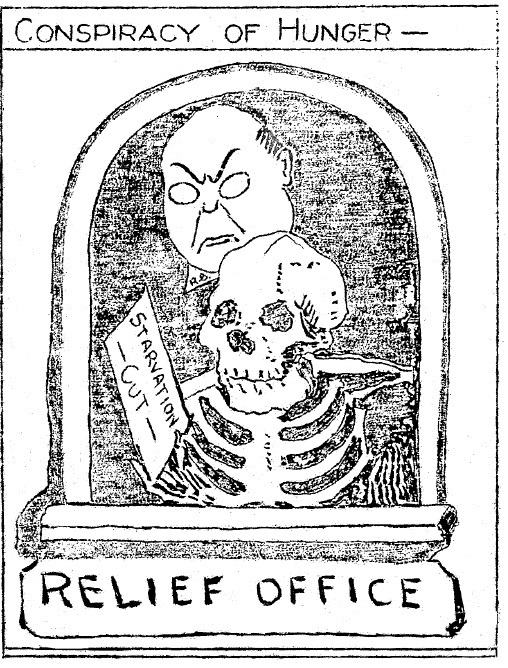
"Conspiracy of Hunger," The Unemployed Worker. May 24, 1933.
===
A starvation cut at the Relief Office
#vancouver#national unemployed workers association#unemployed association#unemployed workers' association#starvation#unemployment relief#relief cut#austerity politics#austerity measures#starve or freeze#capitalism in canada#great depression in canada#communists
20 notes
·
View notes
Photo
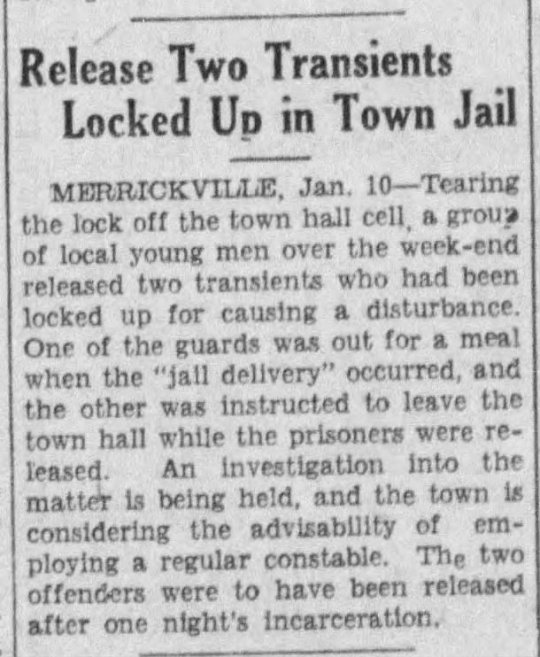
“Release Two Transients Locked Up in Town Jail,” Kingston Whig-Standard. January 10, 1933. Page 1.
----
MERRICKVILLE, Jan. 10— Tearing the lock off the town hall cell, a group of local young men over the week-end released two transients who had been locked up for causing a disturbance. One at the guards was out for a meal when the "jail delivery" occurred and the other was instructed to leave the town hall while the prisoners were released. An investigation into the matter is being held and the town considering the advisability of employing a regular constable. The two offenders were to have been released after one night’s incarceration.
[AL: A wild story. Merrickville is a pretty small town on the Rideau Canal, and had no police force in 1933 - that a group of local young men felt justified in releasing prisoners is remarkable as well. Direct action gets the goods!]
#merrickville#jailbreak#direct action#decarceration#release them all#transients#hobo#fear of transients#youth in revolt#police cells#small town ontario#rideau canal#great depression in canada#crime and punishment in canada#history of crime and punishment in canada
52 notes
·
View notes
Photo
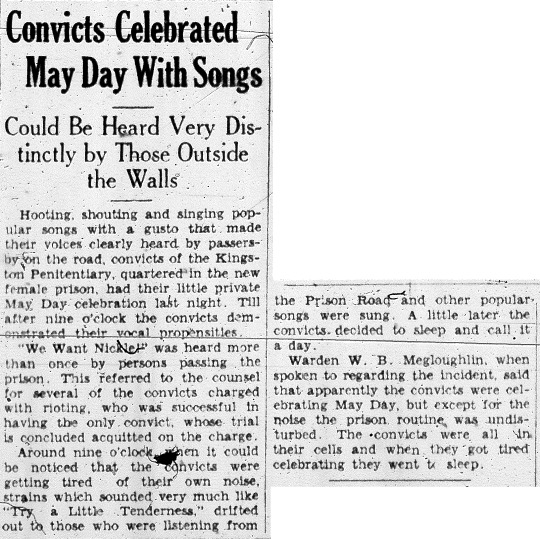
“Convicts Celebrated May Day With Songs,” Kingston Whig-Standard. May 2, 1933. Page 3.
----
Could Be Heard Very Distinctly by Those Outside the Walls
----
Hooting, shouting and singing popular songs with a gusto that made their voices clearly heard by passersby on the road, convicts of the Kingston Penitentiary, quartered in the new female prison, had their little private May Day celebration last night. Till after nine o'clock the convicts demonstrated their vocal propensities.
"We Want Nickle!” was heard more than once by persons passing the prison. This referred to the counsel for several of the convicts charged with rioting, who was successful in having the only convict, whose trial is concluded, acquitted on the charge.
Around nine o'clock when it could be noticed that the convicts were getting tired of their own noise, strains which sounded very much like "Try A Little Tenderness" drifted out to those who were listening from the Prison Road and other popular songs were sung. A little later the convicts decided to sleep and called it a day.
Warden W. B. Megloughlin, when spoken to regarding the incident, said that apparently the convicts were celebrating May Day, but except for the noise the prison routine, was undisturbed. The convicts were all in their cells and when they got tired celebrating they went to sleep.
#kingston ontario#kingston penitentiary#prison for women#may day#try a little tenderness#song in prison#prisoner protest#prison song#convict revolt#1933 prisoner trials#1932 kp riot#great depression in canada#red flag#crime and punishment in canada#history of crime and punishment in canada
28 notes
·
View notes
Text

"JOBLESS SWAMP ALBERTA," Toronto Star. July 29, 1933. Page 2.
-----
Shun Work Camps in B.C., Relief Officials Charge
----
Calgary, July 29. - Following British Columbia's introduction of "no work. no relief" policy. Alberta cities and towns are being flooded by unemployed transients from the coast province, according to relief officials here. The men are leaving British Columbia rather than go to work in relief camps, it is declared.
A. A. Mackenzie, chairman of the Alberta Relief Commission, stated Alberta authorities and police were co-operating upon a plan under which it may be possible to turn back transients at the Great Divide.
#calgary#unemployed#single unemployed men#transients#looking for work#relief camps#relief strike#unemployment relief#alberta relief commission#fear of transients#when freedom was lost#great depression in canada
15 notes
·
View notes
Photo
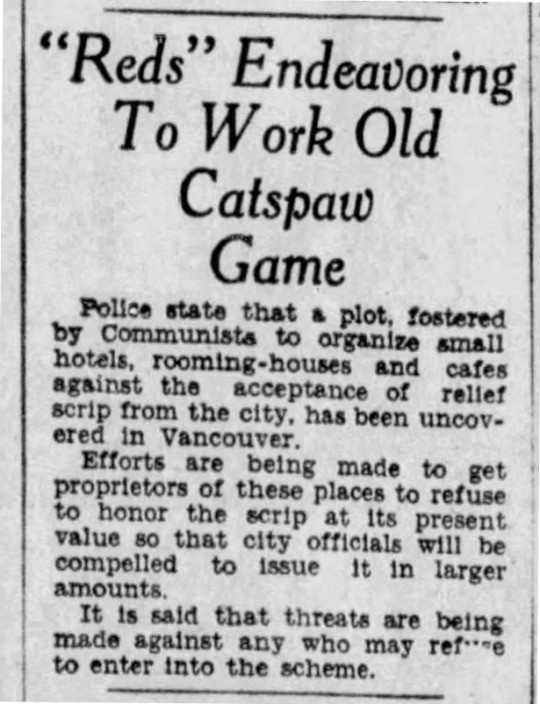
“"Reds” Endeavoring To Work Old Catspaw Game,” The Province (Vancouver). February 23, 1933. Page 2.
---
Police state that a plot, fostered by Communists to organise small hotels, rooming-houses and cafes against the acceptance of relief scrip from the city, has been uncovered in Vancouver.
Efforts are being made to get proprietors of these places to refuse to honor the scrip at its present value, so that city officials will be compelled to issue it in larger amounts.
It is said that threats are being made against any who may refuse to enter into the scheme.
#vancouver#scrip currency#depression scrip#unemployed organizing#unemployment relief#relief vouchers#communists#underground organizing#conspiracy theory#organizing drive#unemployed workers' association#great depression in canada
32 notes
·
View notes
Text

“Girl Stole Flask Of French Perfume,” Toronto Star. December 22, 1932. Page 3.
----
Truthful and Made Restitution Reports Store Detective
----
Whether or not ‘expensive Paris perfurme’ was a necessity in these times was a doubtful question, Magistrate Patterson thought when Brani Smith pleaded guilty, in women’s police court to-day, to stealing a costly flagon of the exotic essence.
The woman was very truthful, a store detective said, and restitution had been made.
Magsitrate Patterson: ‘Those are nice fur coats for people on city relief.’
Crown Attorney Malone, referring to Mrs. Smith and her husband: ‘Camel’s hair.’
Mrs. Smith was remanded till December 29 for sentence. Investigations will be made.
An attractive girl, jobless for some time and without funds, took some pomamengrate of potash tablets. She pleaded guilty to-day to attempting to end her life, and was remanded to the Psychiatric hospital for examination. The girl said she had lost a position through going to work one day while ‘under the weather,’ a city detective told the court.
The aftermath of a charge of threatening against Jean McKinley was that both she and complainant were bound over.
‘The woman came to my door and knocked’ complainant explained, but got no further when her worship reminded him that the case had been dealt with.
#toronto#women's police court#restiution#shoplifting#shoplifters#stolen perfume#stolen furs#class and crime#poverty crimes#unemployed#women in the toils#fines and costs#great depression in canada#crime and punishment in canada#history of crime and punishment in canada
3 notes
·
View notes
Text

"BURNING OF JEWISH BOOKS IS PROTESTED," Winnipeg Tribune. May 11, 1933. Page 2.
----
Close of 1,200 Attend Meeting of Protest Against Nazi Activities
---
The civilized nations of the world. should protest the burning of Jewish books in Germany, declared Rabbi Osher Zilberstein at a protest meeting against the recent Nazi actions held in the Hebrew Free school Wednesday night.
A large audience, numbering close to 1,200, attended the meeting to hear Rabbi Zilberstein, Dr. I. Pearlman, Marcus Hyman, and several other speakers. Ald. M. A. Gray was in the chair.
Rabbi Zilberstein said the protest of the world should say. "Give up your powder and guns, you modern barbarians; such things are a danger, even in the hands of civilized people, much more so in yours; put on bow and arrow and turn back to your woods." He characterized the burning of the books as a "horrible exhibition" and an "insane practice."
The modern mediaevals of Germany burned the records of physics, mathematics, medical science, music and art, only because they were of Jewish authorship. Such things could only be condemned and pitied. Hitler had tried for 14 years to show that the Jews were responsible for Germany's troubles, and later for the world's, but now he was demonstrating that they were responsible only insofar as Einstein's Theory of Relativity, Freud's Psychoanalysis and Heine's poems were.
Dr. Pearlman stated that that not only were the Hitlerites destroying the best that had been created in their world of literature, but an integral part of German culture."They may destroy the books, but they will never succeed in destroying the spirit contained in them," declared S. Miller, another speaker.
#winnipeg#mass meeting#antifascism#jewish canadians#resistance to antisemitism#antinazism#nazi seizure of power#hebrew free school#working class solidarity#jewish folk in canada#fascism in canada#great depression in canada#protest meeting
9 notes
·
View notes